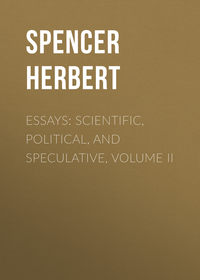 полная версия
полная версияIllustrations of Universal Progress: A Series of Discussions
Comte thus founded social science, and opened a path for future discoverers; but he did not perceive, any more than previous inquirers, the fundamental law of human evolution. It was reserved for Herbert Spencer to discover this all-comprehensive law which is found to explain alike all the phenomena of man's history and all those of external nature. This sublime discovery, that the universe is in a continuous process of evolution from the homogeneous to the heterogeneous, with which only Newton's law of gravitation is at all worthy to be compared, underlies not only physics, but also history. It reveals the law to which social changes conform.
From the Christian ExaminerReverent and bold – reverent for truth, though not for the forms of truth, and not for much that we hold true – bold in the destruction of error, though without that joy in destruction which often claims the name of boldness; – these works are interesting in themselves and in their relation to the current thought of the time. They seem at first sight to form the turning point in the positive philosophy, but closer examination shows us that it is only a new and marked stage in a regular growth. It is the positive philosophy reaching the higher relations of our being, and establishing what before it ignored because it had not reached, and by ignoring seemed to deny. This system formerly excluded theology and psychology. In the works of Herbert Spencer we have the rudiments of a positive theology and an immense step toward the perfection of the science of psychology… Such is a brief and meagre sketch of a discussion which we would commend to be followed in detail by every mind interested in theological studies. Herbert Spencer comes in good faith from what has been so long a hostile camp, bringing a flag of truce and presenting terms of agreement meant to be honourable to both parties: let us give him a candid hearing… In conclusion, we would remark that the work of Herbert Spencer referred to (First Principles) is not mainly theological, but will present the latest and broadest generalizations of science, and we would commend to our readers this author, too little known among us, as at once one of the clearest of teachers and one of the wisest and most honourable of opponents.
From the New EnglanderThough we find here some unwarranted assumptions, as well as some grave omissions, yet this part (Laws of the Knowable) may be considered, upon the whole, as a fine specimen of scientific reasoning. Considerable space is devoted to the "Law of Evolution" the discovery of which is the author's chief claim to originality, and certainly evinces great power of generalization. To quote the abstract definition without a full statement of the inductions from which it is derived would convey no fair impression of the breadth and strength of the thought which it epitomizes. Of Mr. Spencer's general characteristics as a writer, we may observe that his style is marked by great purity, clearness, and force; though it is somewhat diffuse, and the abstract nature of some of his topics occasionally renders his thought difficult of apprehension. His treatment of his subjects is generally thorough and sometimes exhaustive; his arguments are always ingenious if not always convincing; his illustrations are drawn from almost every accessible field of human knowledge, and his method of "putting things" is such as to make the most of his materials. He is undoubtedly entitled to a high rank among the speculative and philosophic writers of the present day…
In Mr. Spencer we have the example of a positivist, who does not treat the subject of religion with supercilious neglect, and who illustrates by his own method of reasoning upon the highest objects of human thought, the value of those metaphysical studies which it is so much the fashion of his school to decry. For both these reasons the volume, which we now propose to examine, deserves the careful attention of the theologian who desires to know what one of the strongest thinkers of his school, commonly thought atheistic in its tendencies, can say in behalf of our ultimate religious ideas. For if we mistake not, in spite of the very negative character of his own results, he has furnished some strong arguments for the doctrine of a positive Christian theology. We shall be mistaken if we expect to find him carelessly passing these matters by (religious faith and theological science) as in all respects beyond knowledge and of no practical concern. On the contrary, he gives them profound attention, and arrives at conclusions in regard to them which even the Christian theologian must allow to contain a large measure of truth. While showing the unsearchable nature of the ultimate facts on which religion depends, he demonstrates their real existence and their great importance… In answering these questions Mr. Spencer has, we think, arrived nearer to a true philosophy than either Hamilton or Mansel. At least he has indicated in a more satisfactory manner than they have done, the positive datum of consciousness that the unconditioned, though inscrutable, exists. It may be said that Mr. Spencer is not chargeable with excluding God from the universe, or denying all revelation of Him in His works, since he earnestly defends the truth that an inscrutable power is shown to exist. We certainly would not charge him with theoretical atheism, holding as he does this ultimate religious idea.
From the North American ReviewThe law of organic development announced in the early part of the present century, by Goethe, Schelling, and Von Baer, and vaguely expressed in the formula, that "evolution is always from the homogenous to the heterogeneous, and from the simple to the complex," has recently been extended by Herbert Spencer so as to include all phenomena whatsoever. He has shown that this law of evolution is the law of all evolution. Whether it be in the development of the earth or of life upon its surface, in the development of Society, of government, of manufactures, of commerce, of language, literature, science and art, this same advance from the simple to the complex, through successive differentiations, holds uniformly. The stupendous induction from all classes of phenomena by which Mr. Spencer proceeds to establish and illustrate his theorem cannot be given here.
From the Christian Spectator (English)Mr. Spencer claims for his view that it is not only a religious position, but preëminently the religious position; and we are most thoroughly disposed to agree with him, though we think he does not appreciate the force of his own argument, nor fully understand his own words. For let us now attempt to realize the meaning of this fact, of which Mr. Spencer and his compeers have put us in possession; let us endeavour to see whether its bearings are really favorable or adverse to religion. They are put forward indeed avowedly as adverse to any other religion than a mere reverential acquiescence in ignorance concerning all that truly exists; but it appears to us that this supposed opposition to religion arises from the fact that the doctrine itself is so profoundly, so intensely, so overwhelmingly religious, nay, so utterly and entirely Christian, that its true meaning could not be seen for very glory. Like Moses, when he came down from the Mount, this positive philosophy comes with a veil over its face, that its too divine radiance may be hidden for a time. This is Science that has been conversing with God, and brings in her hand His law written on tables of stone.
From the ReaderTo answer the question of the likelihood of the permanence of Mr. Mill's philosophic reign, … we should have to take account, among other things, of the differences from Mr. Mill already shown by the extraordinarily able and peculiarly original thinker whose name we have associated with Mr. Mill's at the head of this article. We may take occasion, at another time, to call attention to these speculations of Mr. Herbert Spencer, whose works in the meantime, and especially that new one whose title we have cited, we recommend to all those select readers whose appreciation of masterly exposition, and great reach and boldness of generalization, does not depend on their mere disposition to agree with the doctrines propounded.
From the British Quarterly ReviewComplete in itself, it is at the same time but a part of a whole, which, if it should be constructed in proportion, will be ten times as great. For these First Principles are merely the foundation of a system of philosophy, bolder, more elaborate and comprehensive, perhaps, than any other which has been hitherto designed in England… Widely as it will be seen we differ from the author on some points, we very sincerely hope he may succeed in accomplishing the bold and magnificent project he has mapped out.
From the Cornhill MagazineOur "Survey," superficial as it is, must include at least the mention of a work so lofty in aim, and so remarkable in execution as the system of Philosophy which Mr. Herbert Spencer is issuing to subscribers… In spite of all dissidence respecting the conclusions, the serious reader will applaud the profound earnestness and thoroughness with which these conclusions are advocated; the universal scientific knowledge brought to bear on them by way of illustration, and the acute and subtle thinking displayed in every chapter.
From the ParthenonBy these books he has wedged his way into fame in a manner distinctly original, and curiously marked… There is a peculiar charm in this author's style, in that it sacrifices to no common taste, while at the same time it makes the most abstruse questions intelligible… The book, if it is to be noticed with the slightest degree of fairness, requires to be read and re-read, to be studied apart from itself and with itself. For whatever may be its ultimate fate – although as the ages go on it shall become but as the lispings of a little child, a little more educated than other lisping children of the same time – this is certain, that, as a book addressed to the present, it lifts the mind far above the ordinary range of thought, suggests new associations, arranges chaotic pictures, strikes often a broad harmony, and even moves the heart by an intellectual struggle as passionless as fate, but as irresistible as time.
From the CriticMr. Spencer is the foremost mind of the only philosophical school in England which has arrived at a consistent scheme… Beyond this school we encounter an indolent chaotic eclecticism. Mr. Spencer claims the respect due to distinct and daring individuality; others are echoes or slaves. Mr. Spencer may be a usurper, but he has the voice and gesture of a king.
From the Medico-Chirurgical ReviewMr. Spencer is equally remarkable for his search after first principles; for his acute attempts to decompose mental phenomena into their primary elements; and for his broad generalizations of mental activity, viewed in connection with nature, instinct, and all the analogies presented by life in its universal aspects.
EDITOR'S PREFACE
The essays contained in the present volume were first published in the English periodicals – chiefly the Quarterly Reviews. They contain ideas of permanent interest, and display an amount of thought and labor evidently much greater than is usually bestowed on review articles. They were written with a view to ultimate republication in an enduring form, and were issued in London with several other papers, under the title of "Essays; Scientific, Political, and Speculative," first and second series; – the former appearing in 1857, and the latter in 1863.
The interest created in Mr. Spencer's writings by the publication in this country of his valuable work on "Education," and by criticisms of his other works, has created a demand for these discussions which can only be supplied by their republication. They are now, however, issued in a new form, and are more suited to develop the author's purpose in their preparation; for while each of these essays has its intrinsic and independent claims upon the reader's attention, they are all at the same time but parts of a connected and comprehensive argument. Nearly all of Mr. Spencer's essays have relations more or less direct to the general doctrine of Evolution – a doctrine which he has probably done more to unfold and illustrate than any other thinker. The papers comprised in the present volume are those which deal with the subject in its most obvious and prominent aspects.
Although the argument contained in the first essay on "Progress; its Law and Cause," has been published in an amplified form in the author's "First Principles," it has been thought best to prefix it to the present collection as a key to the full interpretation of the other essays.
To those who read this volume its commendation will be superfluous; we will only say that those who become interested in his course of thought will find it completely elaborated in his new System of Philosophy, now in course of publication.
The remaining articles of Mr. Spencer's first and second series will be shortly published, in a volume entitled "Essays; Moral, Political, and Æsthetic."
New York, March, 1864.
I.
PROGRESS: ITS LAW AND CAUSE
The current conception of Progress is somewhat shifting and indefinite. Sometimes it comprehends little more than simple growth – as of a nation in the number of its members and the extent of territory over which it has spread. Sometimes it has reference to quantity of material products – as when the advance of agriculture and manufactures is the topic. Sometimes the superior quality of these products is contemplated: and sometimes the new or improved appliances by which they are produced. When, again, we speak of moral or intellectual progress, we refer to the state of the individual or people exhibiting it; while, when the progress of Knowledge, of Science, of Art, is commented upon, we have in view certain abstract results of human thought and action. Not only, however, is the current conception of Progress more or less vague, but it is in great measure erroneous. It takes in not so much the reality of Progress as its accompaniments – not so much the substance as the shadow. That progress in intelligence seen during the growth of the child into the man, or the savage into the philosopher, is commonly regarded as consisting in the greater number of facts known and laws understood: whereas the actual progress consists in those internal modifications of which this increased knowledge is the expression. Social progress is supposed to consist in the produce of a greater quantity and variety of the articles required for satisfying men's wants; in the increasing security of person and property; in widening freedom of action: whereas, rightly understood, social progress consists in those changes of structure in the social organism which have entailed these consequences. The current conception is a teleological one. The phenomena are contemplated solely as bearing on human happiness. Only those changes are held to constitute progress which directly or indirectly tend to heighten human happiness. And they are thought to constitute progress simply because they tend to heighten human happiness. But rightly to understand progress, we must inquire what is the nature of these changes, considered apart from our interests. Ceasing, for example, to regard the successive geological modifications that have taken place in the Earth, as modifications that have gradually fitted it for the habitation of Man, and as therefore a geological progress, we must seek to determine the character common to these modifications – the law to which they all conform. And similarly in every other case. Leaving out of sight concomitants and beneficial consequences, let us ask what Progress is in itself.
In respect to that progress which individual organisms display in the course of their evolution, this question has been answered by the Germans. The investigations of Wolff, Goethe, and Von Baer, have established the truth that the series of changes gone through during the development of a seed into a tree, or an ovum into an animal, constitute an advance from homogeneity of structure to heterogeneity of structure. In its primary stage, every germ consists of a substance that is uniform throughout, both in texture and chemical composition. The first step is the appearance of a difference between two parts of this substance; or, as the phenomenon is called in physiological language, a differentiation. Each of these differentiated divisions presently begins itself to exhibit some contrast of parts; and by and by these secondary differentiations become as definite as the original one. This process is continuously repeated – is simultaneously going on in all parts of the growing embryo; and by endless such differentiations there is finally produced that complex combination of tissues and organs constituting the adult animal or plant. This is the history of all organisms whatever. It is settled beyond dispute that organic progress consists in a change from the homogeneous to the heterogeneous.
Now, we propose in the first place to show, that this law of organic progress is the law of all progress. Whether it be in the development of the Earth, in the development of Life upon its surface, in the development of Society, of Government, of Manufactures, of Commerce, of Language, Literature, Science, Art, this same evolution of the simple into the complex, through successive differentiations, holds throughout. From the earliest traceable cosmical changes down to the latest results of civilization, we shall find that the transformation of the homogeneous into the heterogeneous, is that in which Progress essentially consists.
With the view of showing that if the Nebular Hypothesis be true, the genesis of the solar system supplies one illustration of this law, let us assume that the matter of which the sun and planets consist was once in a diffused form; and that from the gravitation of its atoms there resulted a gradual concentration. By the hypothesis, the solar system in its nascent state existed as an indefinitely extended and nearly homogeneous medium – a medium almost homogeneous in density, in temperature, and in other physical attributes. The first advance towards consolidation resulted in a differentiation between the occupied space which the nebulous mass still filled, and the unoccupied space which it previously filled. There simultaneously resulted a contrast in density and a contrast in temperature, between the interior and the exterior of this mass. And at the same time there arose throughout it rotatory movements, whose velocities varied according to their distances from its centre. These differentiations increased in number and degree until there was evolved the organized group of sun, planets, and satellites, which we now know – a group which presents numerous contrasts of structure and action among its members. There are the immense contrasts between the sun and planets, in bulk and in weight; as well as the subordinate contrasts between one planet and another, and between the planets and their satellites. There is the similarly marked contrast between the sun as almost stationary, and the planets as moving round him with great velocity; while there are the secondary contrasts between the velocities and periods of the several planets, and between their simple revolutions and the double ones of their satellites, which have to move round their primaries while moving round the sun. There is the yet further strong contrast between the sun and the planets in respect of temperature; and there is reason to suppose that the planets and satellites differ from each other in their proper heat, as well as in the heat they receive from the sun.
When we bear in mind that, in addition to these various contrasts, the planets and satellites also differ in respect to their distances from each other and their primary; in respect to the inclinations of their orbits, the inclinations of their axes, their times of rotation on their axes, their specific gravities, and their physical constitutions; we see what a high degree of heterogeneity the solar system exhibits, when compared with the almost complete homogeneity of the nebulous mass out of which it is supposed to have originated. Passing from this hypothetical illustration, which must be taken for what it is worth, without prejudice to the general argument, let us descend to a more certain order of evidence. It is now generally agreed among geologists that the Earth was at first a mass of molten matter; and that it is still fluid and incandescent at the distance of a few miles beneath its surface. Originally, then, it was homogeneous in consistence, and, in virtue of the circulation that takes place in heated fluids, must have been comparatively homogeneous in temperature; and it must have been surrounded by an atmosphere consisting partly of the elements of air and water, and partly of those various other elements which assume a gaseous form at high temperatures. That slow cooling by radiation which is still going on at an inappreciable rate, and which, though originally far more rapid than now, necessarily required an immense time to produce any decided change, must ultimately have resulted in the solidification of the portion most able to part with its heat – namely, the surface. In the thin crust thus formed we have the first marked differentiation. A still further cooling, a consequent thickening of this crust, and an accompanying deposition of all solidifiable elements contained in the atmosphere, must finally have been followed by the condensation of the water previously existing as vapour. A second marked differentiation must thus have arisen: and as the condensation must have taken place on the coolest parts of the surface – namely, about the poles – there must thus have resulted the first geographical distinction of parts. To these illustrations of growing heterogeneity, which, though deduced from the known laws of matter, may be regarded as more or less hypothetical, Geology adds an extensive series that have been inductively established. Its investigations show that the Earth has been continually becoming more heterogeneous in virtue of the multiplication of the strata which form its crust; further, that it has been becoming more heterogeneous in respect of the composition of these strata, the latter of which, being made from the detritus of the older ones, are many of them rendered highly complex by the mixture of materials they contain; and that this heterogeneity has been vastly increased by the action of the Earth's still molten nucleus upon its envelope, whence have resulted not only a great variety of igneous rocks, but the tilting up of sedimentary strata at all angles, the formation of faults and metallic veins, the production of endless dislocations and irregularities. Yet again, geologists teach us that the Earth's surface has been growing more varied in elevation – that the most ancient mountain systems are the smallest, and the Andes and Himalayas the most modern; while in all probability there have been corresponding changes in the bed of the ocean. As a consequence of these ceaseless differentiations, we now find that no considerable portion of the Earth's exposed surface is like any other portion, either in contour, in geologic structure, or in chemical composition; and that in most parts it changes from mile to mile in all these characteristics.
Moreover, it must not be forgotten that there has been simultaneously going on a gradual differentiation of climates. As fast as the Earth cooled and its crust solidified, there arose appreciable differences in temperature between those parts of its surface most exposed to the sun and those less exposed. Gradually, as the cooling progressed, these differences became more pronounced; until there finally resulted those marked contrasts between regions of perpetual ice and snow, regions where winter and summer alternately reign for periods varying according to the latitude, and regions where summer follows summer with scarcely an appreciable variation. At the same time the successive elevations and subsidences of different portions of the Earth's crust, tending as they have done to the present irregular distribution of land and sea, have entailed various modifications of climate beyond those dependent on latitude; while a yet further series of such modifications have been produced by increasing differences of elevation in the land, which have in sundry places brought arctic, temperate, and tropical climates to within a few miles of each other. And the general result of these changes is, that not only has every extensive region its own meteorologic conditions, but that every locality in each region differs more or less from others in those conditions, as in its structure, its contour, its soil. Thus, between our existing Earth, the phenomena of whose varied crust neither geographers, geologists, mineralogists, nor meteorologists have yet enumerated, and the molten globe out of which it was evolved, the contrast in heterogeneity is sufficiently striking.









